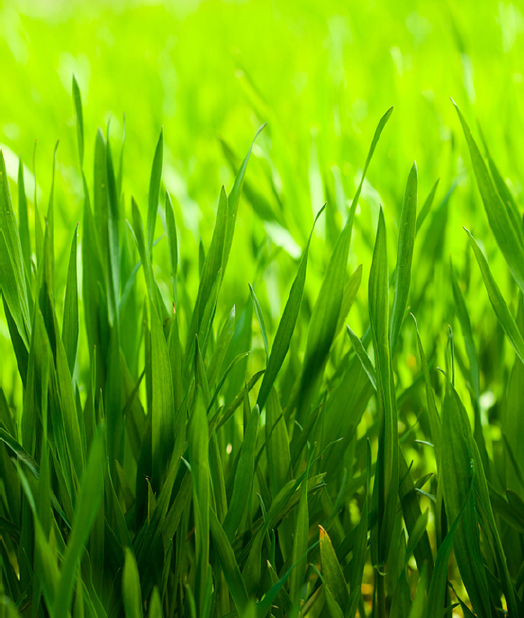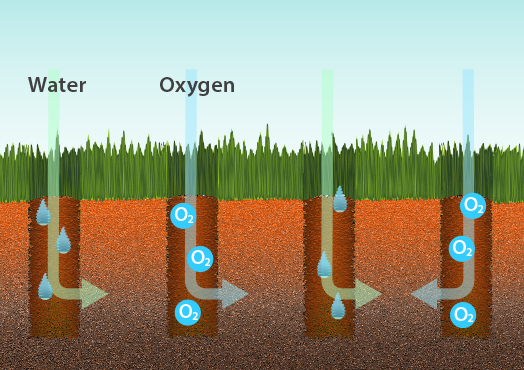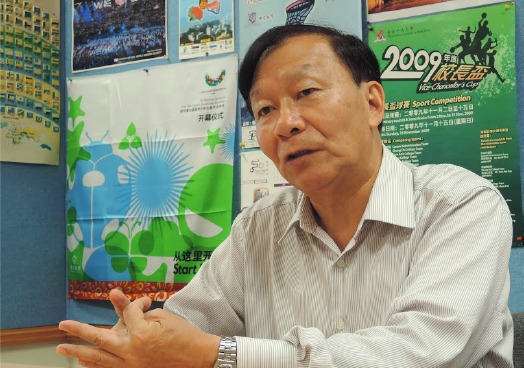Green, Green Grass of CUHK
The Chinese University is known for its green campus, but while its trees have received much attention, one of the lesser-known contributors to this luxuriant image is turf-grass -- painstakingly maintained by the Estates Management Office (EMO) and the Physical Education Unit, and advised by professionals like Prof. Chau Kwai-cheong, adjunct associate professor in the Department of Geography and Resource Management and one of Hong Kong's very few turf specialists.
Requirements for Healthy, Beautiful Grass
Turf-grass can be found in the Colleges, around buildings such as Chung Chi Chapel and the Vice-Chancellor's Lodge, and the football pitches at Sir Philip Haddon-Cave Sports Field and Lingnan Stadium. It's hard work having and maintaining healthy, playable, visually acceptable turf-grass. 'A competent management team of professionals with a solid understanding of the field, and adequate deployable manpower,' said Professor Chau. 'In addition, a solid year-round programme that reflects different maintenance needs based on weather conditions and frequency of use. Equipment is also of crucial importance -- lawn mowers, verticutter to dethatch grass so it doesn't become a breeding ground for insects and fungal diseases, aeration improvement machines, tank sprayers, tools for drainage improvement and fertilization etc.'

Types of Grass
Turf-grass is grass that is specially selected and cultivated for ornamental purposes and/or leisure, play and sports activities, and there are different types. For example, Zoysia matrella or Manila grass and Zoysia japonica or Japanese lawn grass, often used in football pitches, have the benefits of being aesthetically pleasing, and resistant to drought, compaction, and wear resistant. They also grow relatively quickly and densely. 'Grass coverage and shoot density are related to a field's playability. How can a ball roll smoothly if the grass is stemmy and sparse and there's no cushioning effect?' said Professor Chau.
Turf-grass needs a lot of nitrogen for healthy growth, but excessive nitrogen also makes it vulnerable to attack by fungal diseases. Fungus favours hot and humid weather like that in Hong Kong. And if there is a thatch layer - a mat of undecomposed plant material, such as grass clippings, accumulated on the soil surface - the situation gets worse. A thatch layer impedes drainage and becomes a habitat for fungal diseases and insects. Therefore drainage improvement by vertidraining and coring, as well as dethatching are very important to maintaining healthy grass.

Contrary to Zoysia species, carpet-grass of the Axonopus genus, seen in high-profile public spaces such as Hong Kong's Statue Square and the new Government Headquarters, on the other hand, is less resistant to drought and wear. The blades turn red and curl up in winter, reducing coverage of the ground. 'The HKSAR government still uses carpet-grass because Hong Kong does not have the expertise to manage turf-grass properly, unlike the US, Canada, the UK, Australia, and Japan,' observed Professor Chau. 'In the US, about 5 per cent of the GDP is related to the turf-grass industry which means they have a wealth of knowledge in the various aspects of that industry such as grass breeding and research, chemicals and machinery, and the competence to train up professionals. This is not the case in Hong Kong where we still rely on an apprentice system. Though the skills should be relatively easy for a biology or geography graduate to acquire, not many join the field, because the prospects are not financially rewarding except those for golf course superintendents and race track executives.'
CUHK's Turf Maintenance Programme
From September to the end of April, the University's playing fields are used not only by students and for PE classes; they're booked by alumni, staff, the Colleges, departments, even outside organizations. According to the EMO and the PE Unit, each of the University's football pitches has about 1000 users every week, which means they're even more heavily used than Hong Kong's public football fields.
The bulk of turf maintenance or renovation is carried out between May to August when the University breaks for summer. 'You need to keep the turf strong and healthy so it can take some beating during the academic year,' noted Professor Chau. Works include replacing turf-grass by either plugging, sprigging or sodding; improving drainage by vertidraining, which involves punching solid tines into the soil to create equally spaced holes of one inch in diameter and six to eight inches deep, then sending water directly down to the drainage pipes below the root zone. Hollow tining is also used to improve aeration. This is done by punching holes of at least four inches into the soil to allow air to disperse to the roots more easily, and to reduce compaction. The turf is then top-dressed with a layer of sand and drag-matted to level the surface and improve playability.
Regular Maintenance
Besides heavy-duty annual treatment, turf grass needs to be maintained on a regular basis. The playing fields on campus, for example, are given six days off in the 2014-15 academic year, so it could be drained, aerated, combed and fertilized. Problem spots such as areas near the goalposts need more vigorous care to keep the grass from wearing out. Good regular maintenance, such as frequent and proper mowing heights, inhibits the invasion of weeds and prevents the build-up of a thatch layer in the grass. This also means there is less need to spray insecticide and fungicide. In addition, users of the stadium pitches can also contribute to maintain a healthy grass system. This includes avoidance of over-booking, spreading out the wear of grass by rotational use of the entire pitch, replacing divots by players and closure of pitch under inclement weather conditions etc.

'Even turf that is never touched needs to be maintained to stay healthy and look good,' observed Professor Chau. Given the heavy usage of the University's turf-grass, it needs a stringent maintenance programme. But most important in turf management, Professor Chau pointed out, is having a competent management team. 'Turf-grass management is not about grass; it is about people.'
Why are 'Keep Off the Grass' signs so prevalent in Hong Kong?
'First, urban parks and botanical gardens in countries such as the US and Australia are much larger than those in Hong Kong. This means pedestrian traffic is better dispersed and there's less damage to the grass. They also have more expertise in turf management than in Hong Kong. I think there should be a balance between protecting the grass and allowing people to enjoy it.


